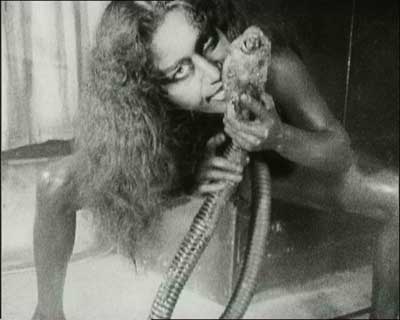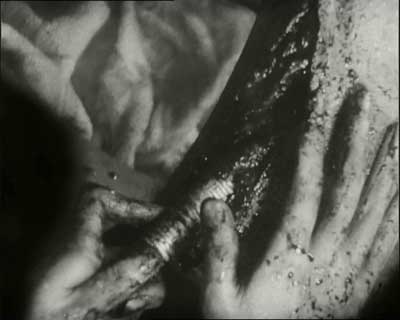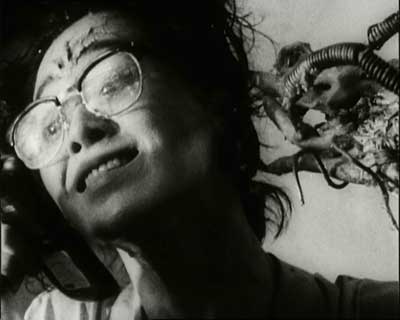Tetsuo: The Iron Man
Breathtakingly baffling hour of indecipherable madness.

If there's one danger that Philips didn't tell you about when purchasing your latest electric razor it's the one chronicled in Japanese auteur and insanity merchant Shinya Tsukamoto's 1988 feature debut (depending on your definition of the term) Tetsuo: The Iron Man. While shaving one morning, what looks like a fuse embeds in Salaryman (Tomorah Taguchi)'s face. While this would perhaps be enough on its own to warrant a product recall, the true horror lies in the fate that befalls Salaryman over the course of the next hour of film.
To describe what happens in Tetsuo doesn't really capture the essence of the film in the same way that more conventional narrative structures does. The short version is that he becomes, well, metallic. It's more of a budgetary constraint than a stylistic choice that he ends up looking like a rejected concept for a Borg, battered circuit boards and wiring glued to his body in a fashion that you'd expect to be funny if it wasn't an integral part of such a mad, mad film.
Despite trying to be supportive of his change, his girlfriend (Kei Fujiwara) is understandably upset by all of this, although it's short lived as Salaryman's penis soon turns into a sizable drill and rips her several new holes. Through what we'll loosely call flashbacks it transpires that Salaryman and his girlfriend were once involved in a hit and run accident, although in this case the pair of them dragged the victim to the woods and had sex in front of him. The victim, played by Tsukamoto himself and occasionally credited as Metals Fetishist, has become similarly afflicted and hunts Salaryman down. Rather than do something conventional like kill Salaryman, Metals Fetishist fuses with him, turning into some crazy tank-like thing tearing off through the city proclaiming that their love will turn this world to metal. Okaaay.

In Britain at least, Tetsuo gains most its notoriety from its position at the forefront of the new wave Japanese films from a generation of directors like Tsukamoto and Takashi Miike. Certainly it's one of my earliest memories of a genre I like to call 'Oriental Freebasing'. Despite it's obvious budgetary limitations and its highly experimental, occasionally student film like leanings Tetsuo is one of the most memorable films you will ever see, although given Tsukamoto's execution you may not want to remember it.
In a word, this film is grotesque. The faint of heart had best not apply as there's all manner of things to be offended here. In the interests of brevity from the summary above I omitted the dream sequence in which Salaryman is violated in a very uncomfortable place by a metal tail his girlfriend has grown, but it seems rude to ignore it completely especially as it's repeated near verbatim in his later film A Snake Of June. There's a bizarre chase sequence between Salaryman and a woman he sits next to at a subway station (credited in a utilitarian way as Woman in Glasses) who also succumbs to this infectious metalicism.
There's shots of flexible pipes and wires protruding from Salaryman. There's a particularly memorable (unfortunately) shot of a festering wound with maggots crawling in it. There's a tramp beating someone up. There's so much insanity going on in such concentrated form that it's pretty much guaranteed to shut your brain down after half an hour. It's a difficult film to watch, requiring near Herculean efforts of concentration and a strong constitution for the unique bizarreness of it's vivid and altogether too obvious imagery.

Tsukamoto set up the Kaiju theatre group a few years previously and they made their name doing such cutting edge, boundary pushing taste challengers of a shorter runtime than this. Being a small operation, double duties were common and while it's not too unusual for a director to also write the story it's a little less common for the main female lead to also be the costume designer. Tsukamoto often worked with Taguchi and their familiarity allows for some of the most apt reaction shots that I've witnessed, and looks of terror and sheer, disturbed past all reason expressions that any number of teen slasher films would kill for.
Categorising this film would prove a nightmare. The top level concept is that of a sci-fi, although it's lack of any useful explanation for the events that unfold wouldn't sit well with the techno-anoraks. In execution it has more in common with a horror movie, although one that's not setting out to make you jump at any particular moment. There's a cumulative effect to all the depravity that proves at once numbing and also more distressing than anything you're likely to see elsewhere.
Another aspect of the 'Oriental Freebasing' genre lies in the willingness to experiment with cinematic techniques in areas that wouldn't normally be considered. While Takashi Miike will think little of having chunks of narrative told in claymation as in The Happiness Of The Katakuris, in Tetsuo many of the special effects shots and more obviously some of the later chase scenes are shot in stop motion, which in a lesser talent's hands (or a less insane tale) would look like a Benny Hill sketch. Here it doesn't jar with it's surroundings in the way you'd expect purely because the rest of the film will have you thrown off-balance beforehand.

If you look hard enough for meaning in anything you will find it. Here the most obvious interpretation is not that of a simple revenge story but one of a fear of what the never ending march of technology and the alienation that seems to derive from it, with none of the characters even given the dignity of a proper name. Given the statements towards the end of the film and the relative squalor that Tsukamoto chooses to show as part of the cityscape, there's also a healthy degree of disrespect for urban conditions. Indeed, Tsukamoto himself says that "Part of me loves a city like Tokyo, but part of me would quite happily destroy it". There's a healthy amount of self loathing mixed in as well, the protagonists eventually literally destroying themselves. Many of these themes find themselves repeated in less extreme and obvious forms throughout Tsukamoto's other works, such as the recently released A Snake Of June.
If you look hard enough for meaning in anything you will find it. However, you shouldn't lose sight of the fact that this is a film where a man's penis turns into a drill and kills someone. You shouldn't lose sight of the fact that it's a film that is deliberately trying to wrong foot you at every turn. You shouldn't lose sight of the fact that this is designed seemingly purely to be confrontational, controversial and shocking with the actual narrative quality suffering as a result. Does it merit a more intellectual analysis?
That's a judgement call, and it's not really one that I can make for you. Especially with experimental musician Chu Ishikawa's pounding and relentless techno-industrial soundtrack, you may think this nothing more than an extended Aphex Twin video. You might think it too much and turn it off after ten minutes. You may think it's the most original film you've ever seen. You may think it a derivative mish-mash of Cronenberg and Lynch. Regardless, you will think about it, and that seems on occasion to be a rare trait among films. Calling it a great film, or even an enjoyable film seems as glib as describing the wind as a good thing or a bad thing. It's a film you ought to see purely on the basis that it's quite unlike anything else and it's guaranteed to give you a different perspective on cinema as a whole, regardless of how you end up feeling about this example of it.
Were I in the business of passing quantifiable judgements, I'd award this 4/5 TippyMarks.
Kei Fujiwara (Girlfriend)
Nobu Kanaoka (Woman in Glasses)
Renji Ishibashi (Tramp)
Naomasa Musaka (Doctor)
Shinya Tsukamoto (Metals Fetishist)